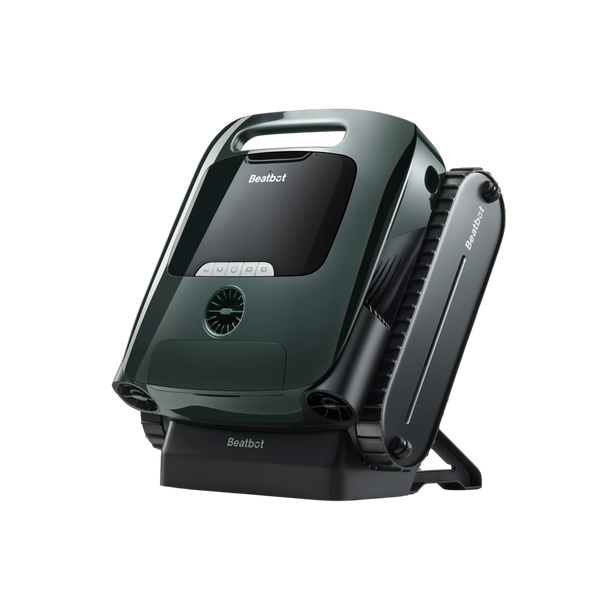Why Mustard Algae Feds Up My Pool and Top Ways to Combat Them
Swimming pools are invaluable venues where people of all ages can enjoy fun, leisure time, and physical exercise, making it particularly important to maintain their cleanliness and health. However, algae proliferation has become a common challenge for pool managers during this process, especially mustard algae , a particularly stubborn and difficult-to-remove type of algae.
Table of content

What is Mustard Algae, and Why is It Considered As One of the Worst Types of Algae?
Mustard algae, also known as yellow algae, is a common harmful algae found in swimming pools. It appears as a thin film with a yellow or mustard-like color, attaching to the pool walls and floor. It is often easily confused with dirt or small sand particles in the pool and may not be immediately noticeable. What is particularly tricky is that mustard algae demonstrates strong resistance to conventional pool disinfection methods, especially chlorination, distinguishing it from other types of algae. Mustard algae prefers to grow in low-flow areas or shaded corners of the swimming pool, further increasing the difficulty of completely removing it.Next, we will elaborate on the sources of mustard algae and a series of effective removal steps.
How does Mustard Algae Boom in Swimming Pools?
Contamination:
Unlike black algae found in natural water bodies, the spread of mustard algae is relatively simple. It can enter your pool through various means, such as rainfall, wind, swimsuits that have not been thoroughly cleaned and disinfected, and bird droppings.
Inadequate Water Circulation Issues
When water circulation in a pool is insufficient, certain areas may remain stagnant, creating an environment conducive to algae proliferation. Algae spores, unable to circulate freely within the water, will begin to settle and adhere to pool surfaces, including walls, floors, and equipment.
Neglected Pool Maintenance
Lack of proper pool maintenance, such as inadequate water circulation, improper water temperature control, and infrequent filtration, can lead to algae formation and accumulation of debris, dirt, and other materials within the pool. Slow-moving water allows debris to settle and accumulate, providing nourishment for algae to proliferate.

Chlorine Deficiency
The task of eradicating algae through regular chlorination becomes more challenging due to algae's resilience to chlorine treatment. Low or fluctuating chlorine levels in the pool provide an optimal environment for algae to thrive, as they find it easier to multiply in such conditions.
Water Chemistry Imbalance Challenges
Improper water chemistry, characterized by variations in pH, alkalinity, or calcium hardness levels, can encourage algae growth. High-pH water and low sanitizer concentrations, especially those prevalent in mustard algae, create an ideal breeding ground for algae.
Effective Steps to Eliminate Mustard Algae
Eliminating mustard algae is both complex and persistent, but by following these steps, you will be able to gradually overcome this challenge:
Water Quality Testing
- Utilize a Professional Pool Testing Kit : First, use a pool testing kit to check the pool water's pH level, alkalinity, and chlorine content.
- Adjust to Optimal Ranges : Ensure that all water quality parameters fall within the recommended ranges, as this is the foundation for effectively eliminating mustard algae.
To effectively prevent mustard algae in your pool, it's important to regularly test your water. Ideally, this should be done once a week. Keeping an eye on key chemistry levels—such as pH, Total Alkalinity, Free Available Chlorine, and phosphates—is crucial to maintaining a well-balanced pool environment.
Key Steps for Testing Your Pool Water:
- Check pH Levels : Ensure they're within the recommended range of 7.2 to 7.8.
- Monitor Total Alkalinity : Keep it balanced between 80-120 ppm.
- Measure Free Available Chlorine : This should remain between 1-3 ppm.
- Observe Phosphate Levels : Try to keep this number as low as possible to discourage algae growth.
By conducting these tests once a week, you'll significantly reduce the risk of stubborn mustard algae taking hold in your pool. Adjust your water chemistry as needed based on these test readings to maintain a clean and healthy swimming environment.
Thorough Brushing
- Employ a Powerful Pool Brush : Pick up your pool brush and vigorously scrub the affected areas to loosen the mustard algae from the pool walls and floor.
- Comprehensive Coverage : Don't forget to brush all surfaces of the pool, including steps and corners, where mustard algae often hide.
Enhanced Chlorination Treatment
- Select a High-Efficiency Chlorine Shock Treatment : Next, use a pool shock treatment containing a high concentration of chlorine to kill the mustard algae.
- Follow Instructions Carefully : Strictly adhere to the instructions on the product packaging and maintain the pool's chlorine levels for several days to prevent mustard algae from regenerating.
Application of Specialized Algaecide
- Choose an Algaecide Targeted at Mustard Algae : Select an algaecide specifically designed to combat mustard algae.
- Timing is Key : Add the algaecide after the chlorination treatment to avoid any interaction between the two, ensuring maximum effectiveness.
Deep Cleaning
- Use a Pool Vacuum Cleaner : Once the mustard algae have been killed, use a pool cleaner to thoroughly clean the pool, paying special attention to the previously affected areas.
- Thorough Removal : Ensure that every corner is cleaned thoroughly, leaving no room for any remnants.
In this regard, robotic pool cleaners are experts. They are like the Roomba for your pool, easily sucking up all kinds of tiny debris that are difficult to handle and preventing algae outbreaks from recurring. We recommend the Beatbot AquaSense Pro, which can clean the pool walls, floor, and surface, as well as perform efficient water clarification. If you want to ensure thorough algae removal, definitely consider it.

Continuous Maintenance
Maintain Chemical Balance : After eliminating the mustard algae, continue to maintain the pool's chemical balance by regularly testing and adjusting the water quality. Focus on keeping pH, Total Alkalinity, Free Available Chlorine, and phosphates at optimal levels.
Regular Brushing and Vacuuming : Keep the pool clean through regular brushing and vacuuming to prevent mustard algae from returning.
Circulation and Shocking
Run the Pool Pump : Ensure your pool pump runs at least 8 hours daily. This enhances water circulation, which is crucial in preventing algae buildup.
Pool Shocking : Shock your pool before and after heavy use to eliminate organic contaminants that contribute to algae growth.
Additional Preventive Measures
Algae-Fighting Products : Incorporate algae-fighting products into your weekly routine. These can provide an extra layer of defense against algae resurgence.
Weekly Testing : Test your pool water weekly to monitor and maintain all chemical levels. This proactive approach helps catch any imbalances early, reducing the risk of algae returning.
By integrating these strategies, you'll create a comprehensive defense against mustard algae, ensuring your pool remains clean, clear, and inviting all season long.
Seek Professional Advice
- Consult a Pool Expert : If the mustard algae problem persists, it is recommended to consult a pool maintenance expert for more professional treatment advice and preventive measures.
Remember, eliminating mustard algae may require multiple treatments, but as long as you persist and follow these steps, you will gradually restore your pool to a clean and healthy state.
Cleaning Your Pool Filter Post-Shock to Eradicate Mustard Algae
After giving your pool a robust shock treatment to combat mustard algae, it's essential to thoroughly clean your filter to ensure optimal water clarity and hygiene. Here's how to tackle the task effectively:
Wait for the Shock to Settle
Allow at least 12 hours for the shock treatment to fully circulate throughout your pool. This ensures that the chemicals have done their job in targeting the algae.Turn Off the Pool Pump
Once the waiting period is over, switch off your pool pump to safely perform the cleaning process.-
Clean Your Specific Filter Type
Sand Filter : Engage in a backwashing process to remove trapped debris and algae. Run the backwash until the water in the sight glass appears clear, usually requiring a couple of minutes.
Diatomaceous Earth (D.E.) Filter : Backwash your D.E. Filter similarly to a sand filter. Additionally, you may need to add fresh D.E. Powder to replace the media lost during backwashing. Consult your filter’s instructions for specifics.
Cartridge Filter : Remove the cartridge from its housing and hose it down to eliminate residual algae and grime. For a more thorough cleaning, soak the cartridge in a filter cleaning solution before rinsing.
Reassemble and Test
Reassemble your filter components and restart the pool pump. Make sure to check that the filtration system is running smoothly and efficiently.
By taking these steps, you not only clean your filter but also enhance its longevity and performance, keeping your pool pristine and inviting.
Relative Blogs
About the author



















